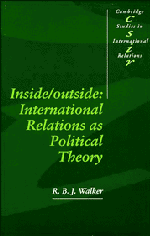Book contents
- Frontmatter
- Contents
- Preface
- 1 International relations as political theory
- 2 The Prince and ‘the pauper’
- 3 Ethics, modernity, community
- 4 History, structure, reification
- 5 Realism and change
- 6 The territorial state and the theme of Gulliver
- 7 On the spatio-temporal conditions of democratic practice
- 8 Sovereign identities and the politics of forgetting
- Notes
- Bibliography
- Index
- Frontmatter
- Contents
- Preface
- 1 International relations as political theory
- 2 The Prince and ‘the pauper’
- 3 Ethics, modernity, community
- 4 History, structure, reification
- 5 Realism and change
- 6 The territorial state and the theme of Gulliver
- 7 On the spatio-temporal conditions of democratic practice
- 8 Sovereign identities and the politics of forgetting
- Notes
- Bibliography
- Index
Summary
Political realism and political realisms
In the early 1980s, the relative optimism of the previous decade receded in the wake of a harsher international environment, and many international relations theorists offered to console us with an old but appropriately mournful tune. This time pessimism came in a more thoroughly modern idiom, derived variously from structuralist social theory, hypothetico-deductive methodologies and utilitarian microeconomics. Since then, neorealism, as this idiom was quickly baptised, has had a profound and in some places even hegemonic influence on the analysis of contemporary world politics.
It is not surprising that in reflecting critically on this trend, Richard Ashley was reminded of the returning ghost of old revolutions: tragedy revived as farce. Yet such reminders risk invoking a view of history that is deeply at odds with the historical narrative preferred by many of those who think of themselves as political realists. For them, the returning ghost merely reflects the inevitable return of tragedy itself. Against the view of history as qualitative progression they offer the claim that the ‘realities’ of international politics are enduring, and are consequently to be distinguished sharply from the politics of state and civil society. Yet the character of this enduring, of this sense of continuity that is also a form of change through time, remains highly problematic. It is even less surprising, therefore, that the reinvigoration of political realism has been accompanied by a renewed concern with the analysis of change in international politics.
- Type
- Chapter
- Information
- Inside/OutsideInternational Relations as Political Theory, pp. 104 - 124Publisher: Cambridge University PressPrint publication year: 1992

